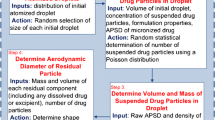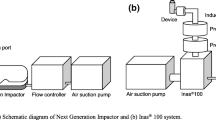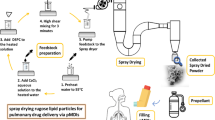Abstract
The purpose of this research was to investigate the measurement and in vitro delivery implications of multimodal distributions, occurring near or in the respirable range, emitted from pressurized metered-dose inhalers (pMDIs). Particle size distributions of solution pMDIs containing hydrofluoroalkane-134a (HFA-134a) and ethanol were evaluated using 2 complementary particle-sizing methods: laser diffraction (LD) and cascade impaction (CI). Solution pMDIs were formulated from mixtures of HFA-134a (50%–97.5% wt/wt) and ethanol. A range of propellant concentrations was selected for a range of vapor pressures. The fluorescent probe, Rhodamine B, was included for chemical analysis. The complementary nature of LD and CI allowed identification of 2 dominant particle size modes at 1 and 10 μm or greater. Increasing propellant concentrations resulted in increases in the proportion of the size distributions at the 1-μm mode and also reduced the particle size of the larger droplet population. Despite significant spatial differences and time scales of measurement between the particle-sizing techniques, the fine particle fractions obtained from LD and CI were practically identical. This was consistent with LD experiments, which showed that particle sizes did not decrease with increasing measurement distance, and may be explained by the absence of significant evaporation/disintegration of larger droplets. The fine particle fractions (FPFs) emitted from HFA-134a/ethanol solution pMDI can be predicted on the basis of formulation parameters and is independent of measurement technique. These results highlight the importance of presenting particle size distribution data from complementary particle size techniques.
Similar content being viewed by others
References
Alexander DJ. Safety of propellants. J Aerosol Med. 1995;8(suppl 1):S 29–34.
Vervaet C, Byron PR. Drug-surfactant-propellant interactions in HFA-formulations. Int J Pharm. 1999;186(1):13–30.
Blondino FE, Byron PR. Surfactant dissolution and water solubilization in chlorine-free liquified gas propellants. Drug Dev Ind Pharm. 1998;24(10):935–945.
Smith IJ. The challenge of reformulation. J Aerosol Med. 1995;8(suppl 1):S 19–27.
Warren SJ, Farr SJ. Formulation of solution metered dose inhalers and comparison with aerosols emitted from conventional suspension systems. Int J Pharm. 1995;124:195–203.
Seale JP, Harrison LI. Effect of changing the fine particle mass of inhaled beclomethasone dipropionate on intrapulmonary deposition and pharmacokinetics. Respir Med. 1998;92(suppl A):9–15.
Leach C. Effect of formulation parameters on hydrofluoroalkane-beclomethasone dipropionate drug deposition in humans. J Allergy Clin Immunol. 1999;104(6):S 250–252.
Leach CL, Davidson PJ, Hasselquist BE, Boudreau RJ. Lung deposition of hydrofluoroalkane-134a beclomethasone is greater than that of chlorofluorocarbon fluticasone and chlorofluorocarbon beclomethasone: a cross-over study in healthy volunteers. Chest. 2002;122(2):510–516.
Dunbar CA, Watkins AP, Miller JF. An experimental investigation of the spray issued from a pMDI using laser diagnostic techniques. J Aerosol Med. 1997;10(4):351–368.
Cheng YS, Fu CS, Yazzie D, Zhou Y. Respiratory deposition patterns of salbutamol pMDI with CFC and HFA-134a formulations in a human airway replica. J Aerosol Med. 2001;14(2):255–266.
Polli GP, Grim WM, Bacher FA, Yunker MH. Influence of formulation on aerosol particle size. J Pharm Sci. 1969;58:484–486.
Williams RO, Liu J. Influence of formulation additives on the vapor pressure of hydrofluoroalkane propellants. Int J Pharm. 1998;166:99–103.
Tzou T-Z. Density, excess molar volume, and vapor pressure of propellant mixtures in metered-dose inhalers: deviation from ideal mixtures. In: Dalby RN, Byron PR, Farr SJ, eds. Respiratory Drug Delivery VI. Buffalo Grove, IL: Interpharm Press, Inc; 1998:439–443.
Martin A. Physical Pharmacy. 4th ed. Philadephia, PA: Lippincott Williams & Wilkins; 1993.
Smyth HDC, Hickey AJ. Comparative particle size analysis of solution propellant driven metered dose inhalers using cascade impaction and laser diffraction. In: Dalby RN, Byron PR, Farr SJ, Peart J, eds. Respiratory Drug Delivery VIII. Raleigh, NC: DHI Publishing; 2002:731–734.
United States Pharmacopeia. USP24/NF19. General chapter <601> Aerosols. In: United States Pharmacopeia. Rockville, MD: United States Pharmacopeia; 1999: 1895.
Ranucci J. Dynamic plume-particle size analysis using laser diffraction. Pharm Tech. 1992;16:108, 110, 112, 114.
Newman SP. Use of gamma scintigraphy to evaluate the performance of new inhalers. J Aerosol Med. 1999; 12(suppl 1):S25–31.
Clark AR. Metered Atomization for Respiratory Drug Delivery [dissertation]. Leicestershire, UK: Loughborough University of Technology; 1991.
Dunbar CA, Watkins AP, Miller JF. Theoretical investigation of the spray from a pressurized metered-dose inhaler. Atomization Sprays. 1997;7(4):417–436.
Finlay WH. The Mechanics of Inhaled Pharmaceutical Aerosols. London, UK: Academic Press; 2001.
Holzner PM, Mueller BW. Particle size determination of metered-dose inhalers by laser diffraction, cascade impaction and liquid impingement. Paper Presented at 1st World Meeting on Pharmaceutics, Biopharmaceutics and Pharmaceutical Technology, Budapest, 1995: 765–766.
de Boer AH, Gjaltema D, Hagedoorn P, Frijlink HW. Characterization of inhalation aerosols: a critical evaluation of cascade impactor analysis and laser diffraction technique. Int J Pharm. 2002;249(1–2):219–231.
Everard ML. CFC transition: the emperors new clothes. Each class of drug deserves a delivery system that meets its own requirements. Thorax. 2000;55:811–814.
Leach C. Enhanced drug delivery through reformulating MDIs with HFA propellants: drug deposition and its effect on preclinical and clinical programs. In: Dalby RN, Byron PR, Farr SJ, eds. Respiratory Drug Delivery V. Buffalo Grove, IL: Interpharm Press, Inc; 1996:133–144.
Leach CL, Davidson PJ, Boudreau RJ. Improved airway targeting with the CFC-free HFA-beclomethasone metered-dose inhaler compared with CFC-beclomethasone. Eur Respir J. 1998;12(6):1346–1353.
Lefebvre AH. Atomization and Sprays. London, UK: Taylor & Francis; 1989.
Faeth GM, Hsiang LP, Wu PK. Structure and breakup properties of sprays. Int J Multiphase Flow. 1995;21 (suppl): 99–127.
Author information
Authors and Affiliations
Corresponding author
Rights and permissions
About this article
Cite this article
Smyth, H.D.C. Multimodal particle size distributions emitted from HFA-134a solution pressurized metered-dose inhalers. AAPS PharmSciTech 4, 38 (2003). https://doi.org/10.1208/pt040338
Received:
Accepted:
DOI: https://doi.org/10.1208/pt040338




